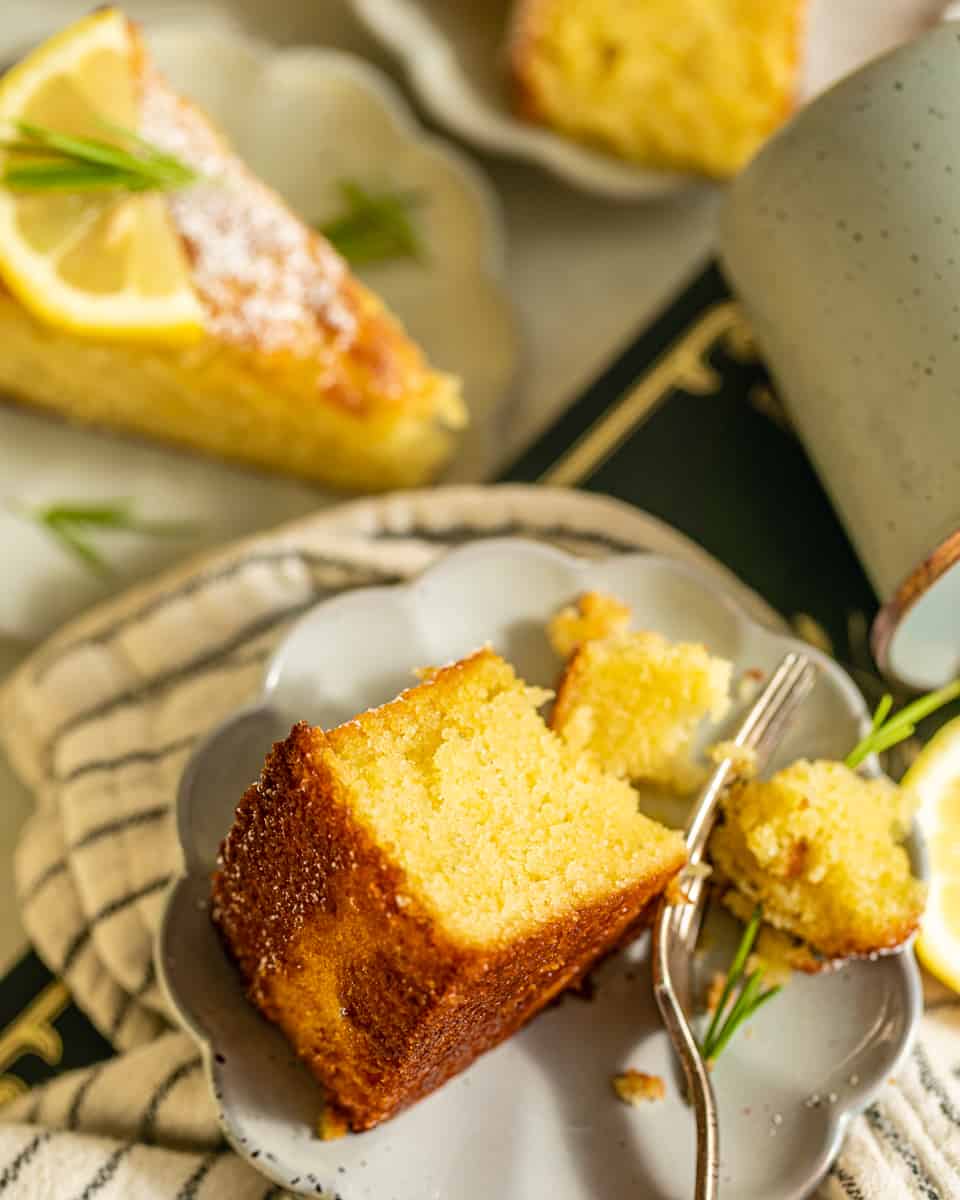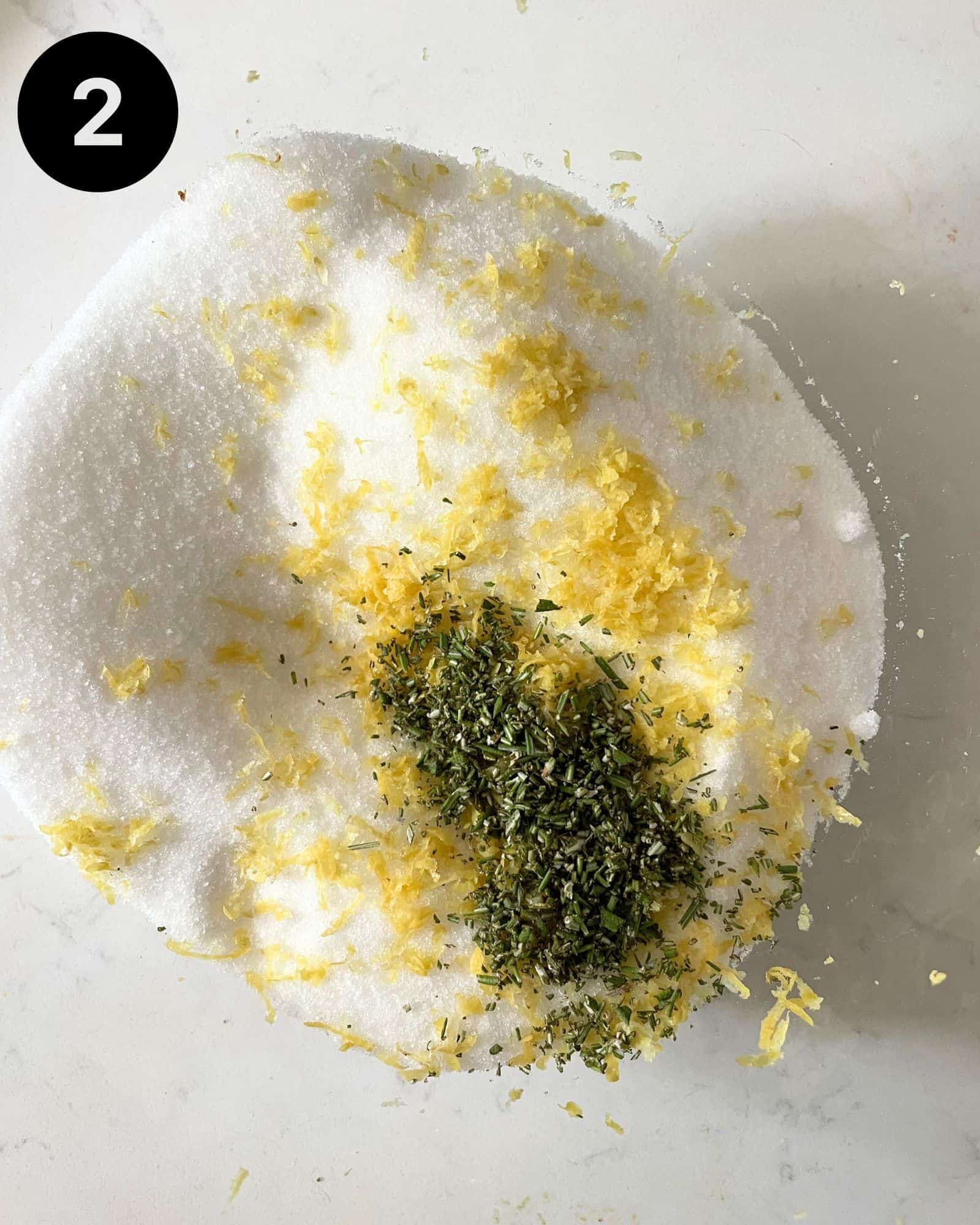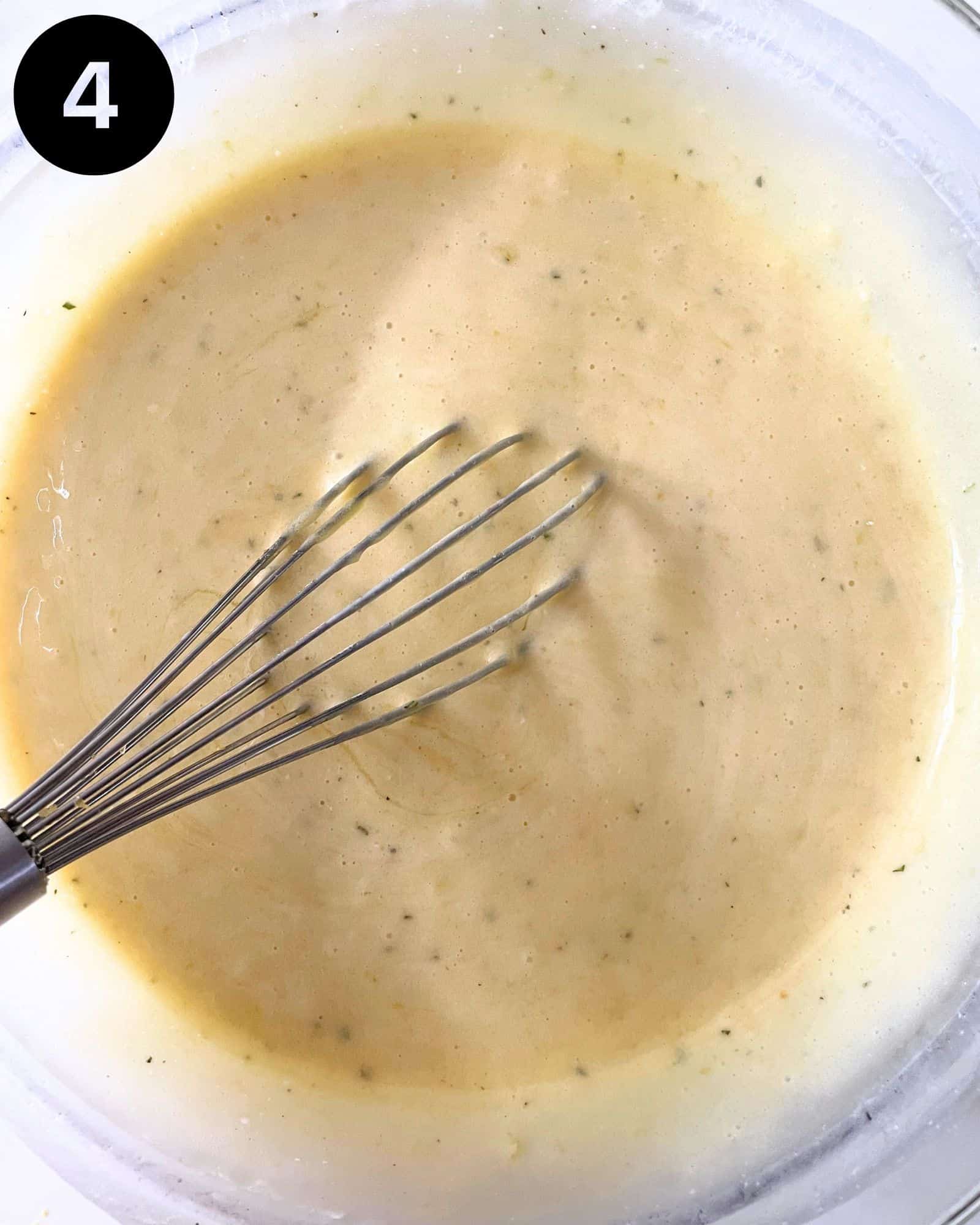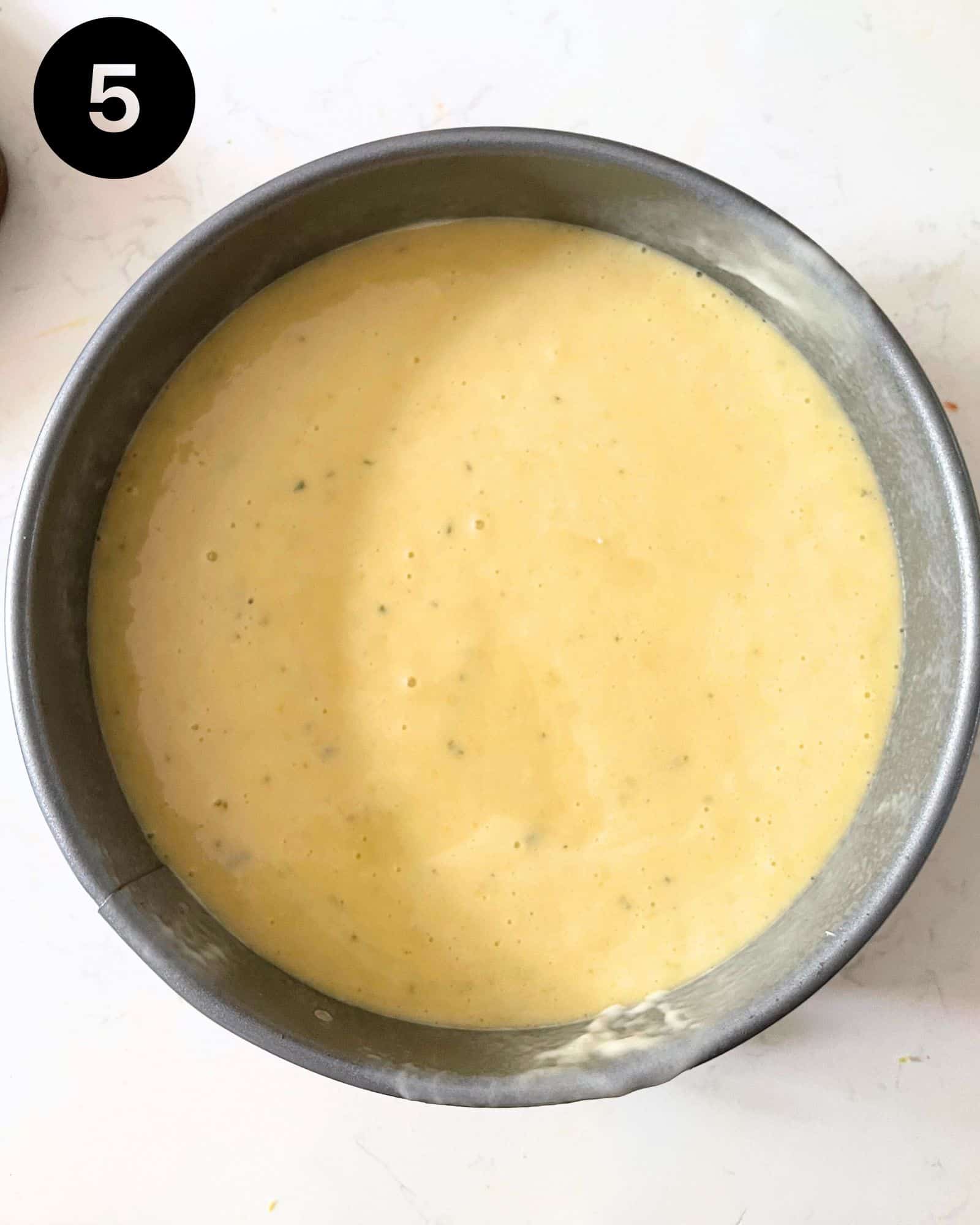Savor this delectable Lemon Rosemary Olive Oil Cake, where the vibrant flavors of citrus, fragrant herbs, and the smoothness of olive oil intertwine to create a truly delightful dessert. To add a touch of sweetness and balance, a light glaze of rosemary and lemon-infused syrup is drizzled over the cake, ensuring each bite is moist and flavorful.
For more lemon desserts, try lemon pound cake loaf, lemon blueberry cake, and lemon raspberry cupcakes.

Jump to:
Imagine the aroma of freshly zested lemons infusing the cake batter, providing a bright and tangy flavor that invigorates your taste buds. To complement the citrusy goodness, the subtle earthy aroma of fragrant rosemary delicately intertwined in the cake.
The herb's gentle presence adds a touch of complexity, elevating the flavor profile to new heights.
What makes this rosemary lemon olive oil cake truly special is the use of olive oil as the primary fat, lending a luxurious and velvety texture to each slice. The olive oil imparts a subtle richness and a hint of fruity undertones, creating a moist and tender crumb that melts in your mouth.
As you take a bite into this perfect cake, the flavors dance together, creating a of taste that is both unique and irresistible.
Why You'll Love this Recipe
- Easy cake recipe! No stand mixer or hand mixer required! Don't worry about dealing with whisk attachment or cleaning up a bunch of dishes, all you need are a large mixing bowl, a saucepan, and a springform pan for this olive oil cake recipe!
- Versatile treat! This dish is amazing with a cup of coffee for breakfast and just as delicious with a scoop of ice cream for dessert!
- Soft and moist texture! This cake has the most beautiful texture that's so moist it melts in your mouth!
- Easily customizable! You can use extra lemon zest or extra rosemary to enhance the flavor of the cake! You can also make this cake dairy free, gluten free, and vegan with a few swaps (listed below).
What kind of olive oil should I use?
The type of olive that you use makes a huge difference in the flavor of the cake. To get that pronounced olive flavor, you should use a quality extra virgin olive oil that is cold pressed, without additives, and has the "extra virgin" seal stating that the oil is authentic. Here's a thorough post all about how to pick the best olive oil for baking.
What You'll Need

Ingredients
- Quality olive oil - use a high quality extra virgin olive oil to truly get that flavor of olive oil in every bite. I used Corto olive oil for its beautiful earthy and full-bodied olive flavor.
- Fresh Rosemary - use fresh rosemary for the best rosemary flavor. Avoid using dried rosemary, the flavor will be too strong.
- Fresh Lemons - use the lemons for both lemon zest and fresh lemon juice. If you can a find meyer lemon, you can use those for a more blended citrus flavor.
- Large Eggs - make sure that the eggs are at room temperature.
- Sugar
- Buttermilk
- Dry ingredients - flour, ground ginger (to enhance the lemon flavor), baking powder, baking soda, and a little kosher salt.
Equipment
- Saucepan
- 9-inch Springform Pan or 9-inch baking pan lined with parchment paper
Recipe Substitutions
Dairy-free option: use your favorite dairy free milk and add a tablespoon of vinegar or apple cider vinegar to replace the buttermilk.
Vegan option: use the dairy free option to replace the buttermilk and also use flax eggs in place of regular eggs.
Gluten-free option: use a 1-to-1 gluten free flour to replace the all purpose flour.
Pro Baking Tips

- Measure accurately: Use precise measurements for the ingredients to ensure the cake turns out moist and well-balanced. Baking is a science, so follow the recipe closely.
- Use room temperature ingredients: Allow your eggs, milk, and any other refrigerated ingredients to come to room temperature before incorporating them into the batter. This ensures better mixing and helps the cake bake evenly.
- Whisk or sift the dry ingredients: Whisk or sift the dry ingredients (flour, baking powder, salt, etc.) together to remove any lumps and distribute them evenly. This step helps to ensure a smooth texture in the final cake.
- Mix gently: When combining the wet and dry ingredients, mix them together gently until just combined. Overmixing can lead to a denser cake. Stir until there are no visible streaks of flour, but avoid overworking the batter.
- Don't overbake: Olive oil cakes tend to be moister than butter-based cakes. Keep a close eye on the baking time and check for doneness with a toothpick or cake tester inserted into the center. The tester should come out with a few moist crumbs attached, but not wet.
- Serve with something complementary! Olive oil cakes pair wonderfully with fresh fruit, a dusting of powdered sugar, a dollop of whipped cream, or a drizzle of citrus glaze. These additions can add an extra layer of flavor and visual appeal.
How to make Olive Oil Cake
- Preheat the oven to 350 degrees F. Spray a 9-inch springform pan with nonstick baking spray and set aside.
- Combine flour, baking powder, baking soda, kosher salt, and ground ginger in a large bowl. Whisk together and set aside.

- In a separate bowl, combine chopped rosemary, lemon zest, and sugar. Use your fingers to rub everything together to infuse the oils of the lemon and rosemary into the sugar. Do this for 3-5 minutes, until the sugar is fragrant and slightly yellow.

- Add the wet ingredients. Pour olive oil, room temperature eggs, and lemon juice to the sugar mixture and whisk for 3-5 minutes, until everything is fully incorporated. Then add half of the dry ingredients and mix together. Pour in the buttermilk, then the remaining half of the dry ingredients.


- Pour batter into the prepared cake pan and bake for one hour, until the top is golden brown.

- While the cake is baking, prepare the rosemary lemon simple syrup. Add sugar, water, 2 sprigs of rosemary, and lemon peels to a small saucepan over medium low heat, stirring occasionally, about 5-10 minutes. Remove the heat and take out the rosemary and lemon peels. Add lemon juice and whisk together slowly. Set aside to cool.

- Once the cake is finished baking, remove from the oven and brush the top of the cake with the rosemary lemon simple syrup then allow the cake to cool completely. Dust with powdered sugar and enjoy!
What to eat with Olive Oil Cake
Here's the best part! I like to garnish with the cooled cake with a little powdered sugar and lemon slices to make it look pretty! After that, the options of what to eat with olive oil cake are endless!
Enjoy a slice of this olive oil rosemary cake with a cup of tea or coffee, or serve it as a delightful finale to a special meal. You can also serve with a little ice cream, whipped cream, or a little lemon curd!
The Lemon Rosemary Olive Oil Cake is a testament to the wonders of combining simple yet vibrant ingredients to create a truly delicious and memorable dessert experience.
Recipe FAQs
Baking with a high quality olive oil gives the cake a subtle earthy flavor. The olive oil contributes mostly to the texture of the cake, more than the flavor, making the cake super tender and moist.
You can add powdered sugar, whipped cream, or ice cream on top of your olive oil cake.
No, it should be covered or stored in an airtight container and kept at room temperature.
More Cake Recipes
- Almond Snack Cake
- Lemon Curd Cake
- Strawberry Crunch Cake
- Philadelphia No Bake Cheesecake
- Strawberry Jam Cake
- Peach Cobbler Pound Cake
Want more delicious and beautiful recipes? Subscribe to my newsletter, where you'll hear about new recipes FIRST and get tantalizing and exclusive perks!
Let's stay connected on social media and continue to cook together! Also, if you decide to make this recipe, please leave a star rating on the recipe card and leave a comment below! Tag @BritneyBreaksBread on Instagram and hashtag #britneybreaksbread so I can see your creations! I hope that you love this recipe as much as we do!

Lemon Rosemary Olive Oil Cake
Equipment
- Mixing Bowls
Ingredients
- 2 cups All Purpose Flour
- ½ tsp Ground Ginger
- ½ tsp Baking Powder
- ½ tsp Baking Soda
- 1 tsp Kosher Salt
- 1 tbsp Fresh Rosemary (diced)
- 1 tbsp Lemon Zest
- 1 ¾ cups Sugar
- 1 cup Olive Oil
- 3 Large Eggs
- ¼ cup Lemon Juice
- 1 cup Buttermilk
Lemon Rosemary Simple Syrup
- ⅓ cup Sugar Lemon peels, ½ lemon 1 tsp lemon juice
- ⅓ cup+ 2 tbsps Water
- 2 sprigs Fresh Rosemary
- ½ Lemon (peels only, see instructions)
- 1 tsp Lemon Juice
Directions
- Preheat the oven to 350 degrees F. Spray a 9-inch springform pan with nonstick baking spray and set aside.
- Combine flour, baking powder, baking soda, kosher salt, and ground ginger in a large bowl. Whisk together and set aside.
- In a separate bowl, combine chopped rosemary, lemon zest, and sugar. Use your fingers to rub everything together to infuse the oils of the lemon and rosemary into the sugar. Do this for 3-5 minutes, until the sugar is fragrant and slightly yellow.
- Add the wet ingredients. Pour olive oil, room temperature eggs, and lemon juice to the sugar mixture and whisk for 3-5 minutes, until everything is fully incorporated. Then add half of the dry ingredients and mix together. Pour in the buttermilk, then the remaining half of the dry ingredients.
- Pour batter into the prepared cake pan and bake for one hour, until the top is golden brown and a toothpick comes out clean or with just a few crumbs.
- While the cake is baking, prepare the rosemary lemon simple syrup. Add sugar, water, 2 sprigs of rosemary, and lemon peels from half of a lemon to a small saucepan over medium low heat, stirring occasionally, about 5-10 minutes. Remove the heat and take out the rosemary and lemon peels. Add lemon juice and whisk together slowly. Set aside to cool.
- Once the cake is finished baking, remove from the oven and brush the top of the cake with the rosemary lemon simple syrup then allow the cake to cool completely. Dust with powdered sugar and enjoy!
Notes
- Measure accurately: Use precise measurements for the ingredients to ensure the cake turns out moist and well-balanced. Baking is a science, so follow the recipe closely.
- Use room temperature ingredients: Allow your eggs, milk, and any other refrigerated ingredients to come to room temperature before incorporating them into the batter. This ensures better mixing and helps the cake bake evenly.
- Whisk or sift the dry ingredients: Whisk or sift the dry ingredients (flour, baking powder, salt, etc.) together to remove any lumps and distribute them evenly. This step helps to ensure a smooth texture in the final cake.
- Mix gently: When combining the wet and dry ingredients, mix them together gently until just combined. Overmixing can lead to a denser cake. Stir until there are no visible streaks of flour, but avoid overworking the batter.
- Don't overbake: Olive oil cakes tend to be more moist than butter-based cakes. Keep a close eye on the baking time and check for doneness with a toothpick or cake tester inserted into the center. The tester should come out with a few moist crumbs attached, but not wet.
- Serve with something complementary! Olive oil cakes pair wonderfully with fresh fruit, a dusting of powdered sugar, a dollop of whipped cream, or a drizzle of citrus glaze. These additions can add an extra layer of flavor and visual appeal.




Any chance you’re thinking of adding metric units to this? I love you’re recipes, it would be so awesome to have the option to covert measurements
Hi! Thanks so much! I actually already have metric measurements added, in the recipe card towards the bottom of the recipe ingredients, you can click on the "customary units or metric" option. I hope this helps!
Are there quantities for the simple syrup?
Yes, please see the recipe card.